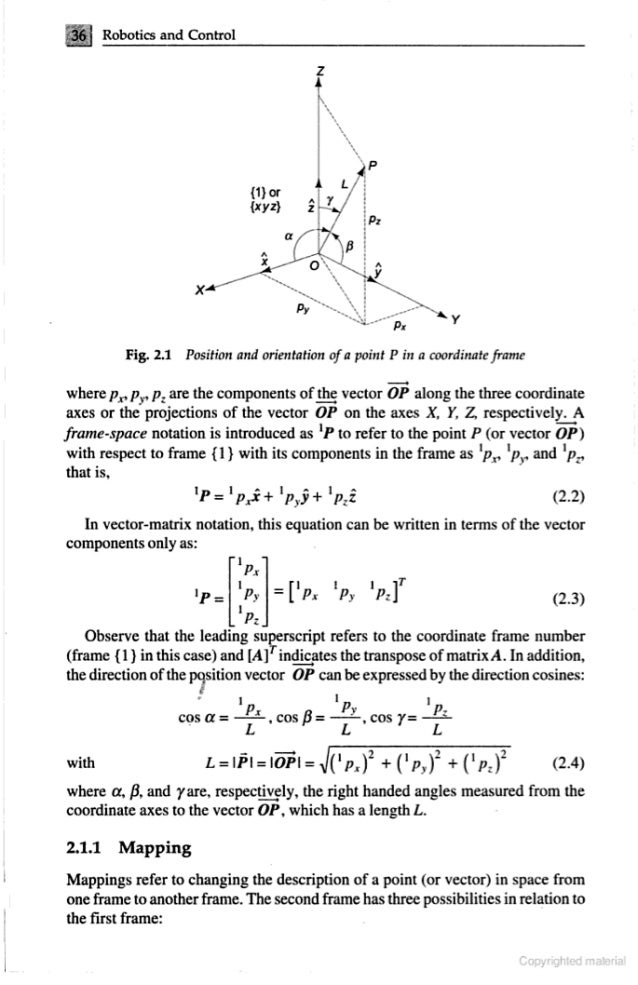
Robotics And Control Mittal And Nagrath Pdf File

Robotics & Control. Bodies of our n - DOF system ( Mittal and Nagrath 2003). For solving these equations, each second - order differential equation should be converted into two first - order.
Author by: Hubert Gattringer Language: en Publisher by: Springer Science & Business Media Format Available: PDF, ePub, Mobi Total Read: 17 Total Download: 900 File Size: 52,8 Mb Description: The volume contains 19 contributions by international experts in the field of multibody system dynamics, robotics and control. The book aims to bridge the gap between the modeling of mechanical systems by means of multibody dynamics formulations and robotics. In the classical approach, a multibody dynamics model contains a very high level of detail, however, the application of such models to robotics or control is usually limited. The papers aim to connect the different scientific communities in multibody dynamics, robotics and control. Main topics are flexible multibody systems, humanoid robots, elastic robots, nonlinear control, optimal path planning, and identification. Author by: Antonio Bicchi Language: en Publisher by: Springer Science & Business Media Format Available: PDF, ePub, Mobi Total Read: 97 Total Download: 405 File Size: 52,7 Mb Description: The?eld of robotics continues to?ourish and develop. In common with general scienti?c investigation, new ideas and implementations emerge quite spontaneously and these are discussed, used, discarded or subsumed at c- ferences, in the reference journals, as well as through the Internet.
Free movie download the wishmaster 4 in hindi. After a little more maturity has been acquired by the new concepts, then archival publication as a scienti?c or engineering monograph may occur. The goal of the Springer Tracts in Advanced Robotics is to publish new developments and advances in the?elds of robotics research – rapidly and informally but with a high quality. It is hoped that prospective authors will welcome the opportunity to publish a structured presentation of some of the emerging robotics methodologies and technologies. The edited volume by Antonio Bicchi, Henrik Christensen and Domenico Prattichizzo is the outcome of the second edition of a workshop jointly sponsored by the IEEE Control Systems Society and the IEEE Robotics and Automation Society. Noticeably, the previous volume was published in the Springer Lecture Notes on Control and Information Sciences.
The authors are recognised as leading scholars internationally. A n- ber of challenging control problems on the forefront of today’s research in robotics and automation are covered, with special emphasis on vision, sensory-feedback control, human-centered robotics, manipulation, planning,?exible and cooperative robots, assembly systems. Author by: Peter Corke Language: en Publisher by: Springer Science & Business Media Format Available: PDF, ePub, Mobi Total Read: 80 Total Download: 477 File Size: 42,6 Mb Description: The practice of robotics and computer vision both involve the application of computational algorithms to data. Over the fairly recent history of the fields of robotics and computer vision a very large body of algorithms has been developed.
However this body of knowledge is something of a barrier for anybody entering the field, or even looking to see if they want to enter the field — What is the right algorithm for a particular problem?, and importantly, How can I try it out without spending days coding and debugging it from the original research papers? The author has maintained two open-source MATLAB Toolboxes for more than 10 years: one for robotics and one for vision. The key strength of the Toolboxes provide a set of tools that allow the user to work with real problems, not trivial examples. For the student the book makes the algorithms accessible, the Toolbox code can be read to gain understanding, and the examples illustrate how it can be used —instant gratification in just a couple of lines of MATLAB code.
The code can also be the starting point for new work, for researchers or students, by writing programs based on Toolbox functions, or modifying the Toolbox code itself. The purpose of this book is to expand on the tutorial material provided with the toolboxes, add many more examples, and to weave this into a narrative that covers robotics and computer vision separately and together. The author shows how complex problems can be decomposed and solved using just a few simple lines of code, and hopefully to inspire up and coming researchers. The topics covered are guided by the real problems observed over many years as a practitioner of both robotics and computer vision. It is written in a light but informative style, it is easy to read and absorb, and includes a lot of Matlab examples and figures. The book is a real walk through the fundamentals of robot kinematics, dynamics and joint level control, then camera models, image processing, feature extraction and epipolar geometry, and bring it all together in a visual servo system.